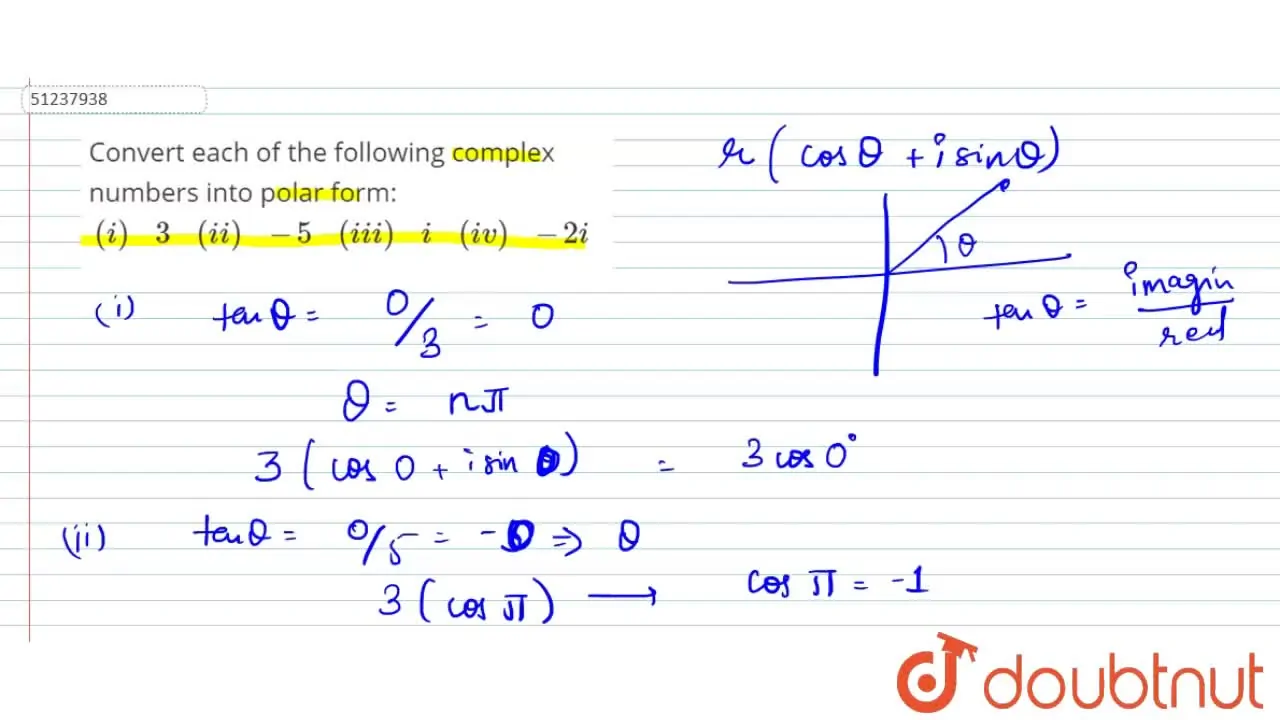Convert each of the following complex numbers into polar form:
(i)3(ii)−5(iii)i(iv)−2i
(i) The given complex number is z = 3 + 0i.
Let its polar form be z=r(cosθ+isinθ).
Now, r=|z|=√32+02=√9=3.
Clearly, z = 3 + 0i is represented by the point P(3, 0), which lies on the positive side of the x-axis.
∴ arg(z)=θ=0.
Thus, r=3andθ=0.
Hence, the required polar form of z=3+0iis3(cos0+isin0).
(ii) The given complex number is z = -5 + 0i.
Let its polar form be z=r(cosθ+isinθ).
Now, r=|z|=√(−5)2+02=√25=5.
Clearly, z = -5 + 0i is represented by the point P(-5, 0), which lies on the negative side of the x-axis.
∴ arg(z)=π⇒θ=π
Thus, r = 5 and θ=π.
Hence, the required polar form of z = -5 + 0i is 5(cosπ+isinπ).
(iii) The given complex number is z = 0 + i.
Let its polar form be z=r(cosθ+isinθ).
Now, r=|z|=√02+12=1.
Clearly, z = 0 + i is respresented by the point P(0, 1), which lies on the y-axis and above the x-axis.
∴ arg(z)=π2⇒θ=π2.
Thus, r=1andθ=π2.
Hence, the requird polar form of z = 0 + i is.
1.(cosπ2+i sinπ2),i.e.,(cosπ2+i sinπ2).
(iv) The given complex number is z = 0 -2i.
Let its polar form be z=r(cosθ+isinθ).
Now, r=|z|=√02+(−2)2=√4=2.
Clearly, z = (0-2i) is represented by the point P(0, -2), which lies on the y-axis and below the x-axis.
∴ arg(z)=−π2⇒θ=−π2.
Thus, r = 2 and θ=−π2. Hence, the required polar form of z = 0 -2i is
z=2{cos(−π2)+isin(−π2)},i.e.,2(cosπ2−i sinπ2).
Related Playlists
- BOOK - RS AGGARWALCHAPTER - COMPLEX NUMBERS AND QUADRATIC EQUATIONSEXERCISE - EXERCISE 5 A15videos
COMPLEX NUMBERS AND QUADRATIC EQUATIONS
- BOOK - RS AGGARWALCHAPTER - COMPLEX NUMBERS AND QUADRATIC EQUATIONSEXERCISE - EXERCISE 5 B28videos
COMPLEX NUMBERS AND QUADRATIC EQUATIONS
- BOOK - RS AGGARWALCHAPTER - COMBINATIONSEXERCISE - Exercise 9D18videos
COMBINATIONS
- BOOK - RS AGGARWALCHAPTER - CONDITIONAL IDENTITIES INVOLVING THE ANGLES OF A TRIANGLE EXERCISE - EXERCISE 1612videos
CONDITIONAL IDENTITIES INVOLVING THE ANGLES OF A TRIANGLE
Similar Questions
Write the following complex numbers in the polar form: −1−i
View SolutionWrite the following complex numbers in the polar form: 1+i
View SolutionWrite the following complex numbers in the polar form: 1−i
View SolutionConvert each of the following complex numbers in polar form:
(i) -3
(ii) √3+i
(iii) i.View SolutionExpress the following complex number in the polar form:1+i1−i
View SolutionConvert of the complex number in the polar form: i
View SolutionWrite the following complex numbers in the polar form: −3√2+3√2i
View SolutionConvert of the complex number in the polar form: −1+i
View SolutionPut the following numbers in the polar form: (2+i3−i)2
View SolutionConvert of the complex number in the polar form: 1−i
View Solution


